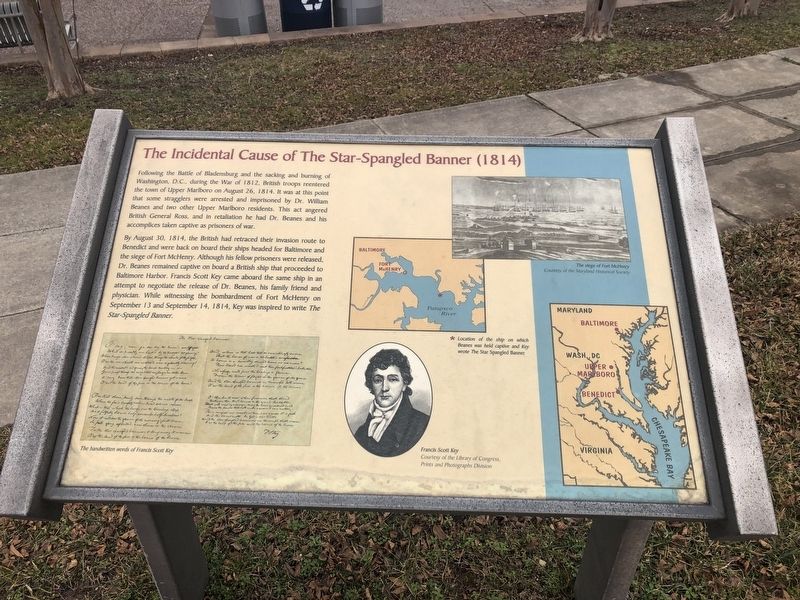Bladensburg in Prince George's County, Maryland — The American Northeast (Mid-Atlantic)
The Incidental Cause of the Star-Spangled Banner (1814)

Photographed By Devry Becker Jones (CC0), February 12, 2021
1. The Incidental Cause of the Star-Spangled Banner (1814) Marker
Following the Battle of Bladensburg and the sacking and burning of Washington, D.C., during the war of 1812, British troops reentered the town of Upper Marlboro on August 26, 1814. It was at this point that some stragglers were arrested and imprisoned by Dr. William Beanes and two other Upper Marlboro residents. This act angered British General Ross, and in retaliation he had Dr. Beanes and his accomplices taken captive as prisoners of war.
By August 30, 1814, the British had retraced their invasion route to Benedict and were back on board their ships headed for Baltimore and the siege of Fort McHenry. Although his fellow prisoners were released, Dr. Beanes remained captive on board a British ship that proceeded to Baltimore Harbor. Francis Scott Key came aboard the same ship in an attempt to negotiate the release of Dr. Beanes, his family friend and physician. While witnessing the bombardment of Fort McHenry on September 13 and September 14, 1814, Key was inspired to write The Star Spangled Banner.
Topics. This historical marker is listed in this topic list: War of 1812. A significant historical month for this entry is September 1836.
Location. 38° 56.116′ N, 76° 56.311′ W. Marker is in Bladensburg, Maryland, in Prince George's County. Marker can be reached from the intersection of Annapolis Road (State Highway 450) and 46th Street. Marker is in Bladensburg Waterfront Park, .2 miles south of the entrance at this intersection. Touch for map. Marker is in this post office area: Bladensburg MD 20710, United States of America. Touch for directions.
Other nearby markers. At least 8 other markers are within walking distance of this marker. Dinosaur Alley (here, next to this marker); Duels and the Bladensburg Dueling Grounds (a few steps from this marker); Encampment of Coxey's Army (1894) (a few steps from this marker); Historic Bladensburg Waterfront Park - Port Town History (within shouting distance of this marker); First Unmanned Balloon Ascension (1784) (within shouting distance of this marker); The Battle of Bladensburg (1814) (within shouting distance of this marker); Colonial Ropemaking (within shouting distance of this marker); The First Telegraph Line (1844) (within shouting distance of this marker). Touch for a list and map of all markers in Bladensburg.
More about this marker. On the lower left is a photo of The handwritten words of Francis Scott Key. In the center is a portrait of Francis Scott Key and on the upper right is a drawing depicting the siege of Fort McHenry. A map in the center shows the approaches to Baltimore, with the locations of Fort McHenry and the ship from which Key witnessed the bombardment. On the lower right is a map of eastern Maryland indicting the locations of Baltimore, Washington, Upper

Photographed By Devry Becker Jones (CC0), December 29, 2023
2. The Incidental Cause of the Star-Spangled Banner (1814) Marker
Also see . . . Dr. William Beanes, the Incidental Cause of the Authorship of the Star-Spangled Banner. By Caleb Clarke Magruder Jr. Records of the Columbia Historical Society, Washington D.C., Vol. 22, (1919), pp. 207-225. (Submitted on October 26, 2013, by Allen C. Browne of Silver Spring, Maryland.)
Credits. This page was last revised on December 29, 2023. It was originally submitted on July 18, 2010, by Craig Swain of Leesburg, Virginia. This page has been viewed 1,674 times since then and 21 times this year. Photos: 1. submitted on February 12, 2021, by Devry Becker Jones of Washington, District of Columbia. 2. submitted on December 29, 2023, by Devry Becker Jones of Washington, District of Columbia. 3. submitted on July 18, 2010, by Craig Swain of Leesburg, Virginia.
